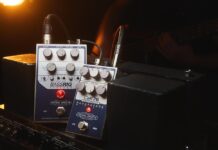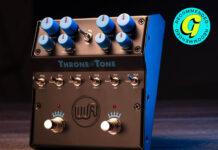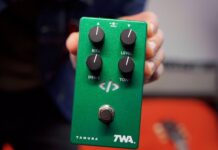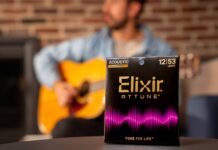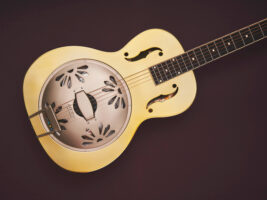
Gretsch G29202 Honey Dipper Special Resonator review: “it comes closer to the sound of a vintage original than anyone might have the right to expect”
$789/£799, gretschguitars.com
The Gretsch Roots Collection has been around for several years now, offering a variety of affordable rootsy resonator guitars and ukuleles crafted in China. The latest shiny addition to the line is a small batch “Bell Brass” release of their metal body resonator – The Honey Dipper. Tasty.
READ MORE: Heritage Ascent+ H-535 review: “this could easily become your new main guitar”
The Honey Dipper takes key design points from the legendary National Triolian design of the late 1920s – there’s a single aluminium cone, a 12 fret neck join, a pair of F-holes in the shoulders and a coverplate with cut-out ornamentation. Where the Gretsch instrument differs at first glance is in the use of Padauk for the bound fingerboard and the solid “paddle” headstock rather than the slot head that we might expect to find on a 12-fret guitar.
Frankly I’m all for this – not only does the risk of bleeding out from a viciously sharp string end lessen, but you also get a genuinely attractive (if undeniably kitsch) headstock covered in pearloid plastic with a great big vertical Gretsch logo to let everyone know that you are a free-thinking acoustic balladeer who won’t conform to labels.
Image: Adam Gasson
Gretsch G29202 Honey Dipper – what is it?
Gretsch describes the Honey Dipper as a round-neck guitar – which is technically correct in that it is not a square-neck instrument designed for lap position playing. With me so far? What may cause some confusion, however, is the pronounced V-shape to that same neck. It’s reasonably comfortable if you’re used to a V profile, but may come as a bit of a shock if you’re not. It is not, by any stretch of the imagination, a rounded C or D shape.
Another thing that may surprise players new to the resonator is the relatively high default action. This is not the slinky string height of a modern acoustic guitar and there are several good reasons at play. First of all, the resonator guitar was originally designed for volume and that often means a heavy hand from the player – with or without finger picks.
There is also the fact that the biscuit bridge of a resonator guitar sits in the centre of the cone and the more downward pressure it gets, the better the guitar sounds. Finally, the joy of a resonator guitar is as a slide instrument and, as anyone who has shifted a brass bottleneck across the strings will know, a higher action will allow for a much clearer sound and help avoid rattling the slide against the frets.
Aside from these notes, the usual resonator health and safety guidelines apply. This is a metal-bodied instrument and is considerably heavier than an acoustic guitar of the same size. Also, for the love of Robert Johnson, do not play this naked on a cold day. With those caveats out of the way let’s head down to the crossroads and see if there’s a deal to be made.
Image: Adam Gasson
Gretsch G29202 Honey Dipper – feel and sounds
Kicking off with some exploratory blues in standard tuning, I am greeted with a chunky sound and a particularly pleasing honk on the 3rd and 4th strings. Don’t be fooled into thinking that a metal-bodied guitar has to sound cold and impersonal. It’s brash but in a good way, and comes closer to the sound of a vintage original than anyone might have the right to expect at this price point.
Entry-level resonator guitars can sound a bit watery, especially in the top end, but the Honey Dipper offers a throaty bark and solid trebles. Very nice. Despite the higher action you can still execute some top string bends too if you’re feeling ambitious.
One important feature here is the 12-fret neck. This, coupled with the 25” scale length, makes for a warmer sound than usually encountered on a 14-fret instrument. It also means a more compact guitar that feels very comfortable against the body here. The real test will be dropping the beast into an open tuning – DADF#AD here we go!
Image: Adam Gasson
A quick point but it’s one worth making: A reso guitar can expect to spend time in several different tunings over the course of its lifetime and Gretsch scores points here for the well-cut nut and smooth Grover Sta-Tite tuners.
There is a deep joy to be found in an open-tuned resonator guitar due to the, well, the resonance. In particular, the sympathetic resonance of open strings vibrating together as you play. It’s like the guitar takes off with a delicious internal reverb. And this does happen with the Honey Dipper to some degree as we dig in – it’s not the choir-like response of a Fine Resophonic guitar by Mike Lewis but it is pleasing nonetheless.
With a heavy brass slide we get a touch of the volume that defines a resonator. These instruments were created in the era before amplification and the ability to fill a room with the voice of your instrument was top of the list of requirements for a musician of the time. The guitar sounds full across the fretboard and there is a satisfyingly grunty bass response here.
The only challenge is hitting the octave notes cleanly on the 12 fret neck, especially if you wear your slide on the 3rd finger – but that’s the nature of the beast and takes only minor adjustment. The V-neck is actually a lot more comfortable with a slide and the whole instrument just works at its best in this context.
Image: Adam Gasson
Gretsch G29202 Honey Dipper – should I buy one?
Now, there is an argument to suggest that the horrific living conditions caused by The Great Depression of the 1920s have been romanticised to the point where the pared-back aesthetic of small brown guitars, ukuleles and resonators has become a design language of its own. As such the looks of an instrument carry as much semantic weight as the sound. This certainly looks and sounds the part.
Given that at the time of writing the Gretsch Roots Collection boasts eight different resonator guitar models, there is every chance that if this guitar doesn’t do it for you then Gretsch will be able to provide you with something that will. That said, the Honey Dipper is an impressive, relatively affordable resonator guitar – if you’re new to the blues or looking for some new textures in the studio then have at it!
Image: Adam Gasson
Gretsch G29202 Honey Dipper – alternatives
If you really want to get authentic with your Depression-era resonators, then you can always try and pick up an original 1930s National Triolian – though you’ll be paying the thick end of five grand for the privilege. If you want an even more affordable resonator option, UK brand Gear4Music’s in-house Hartwood Electro Resonator is a snip at $570/£449.99, while a Johnson 995 Biscuit Electro Resonator ($1,223/£999) is another solid mid-priced option.
The post Gretsch G29202 Honey Dipper Special Resonator review: “it comes closer to the sound of a vintage original than anyone might have the right to expect” appeared first on Guitar.com | All Things Guitar.
Source: www.guitar-bass.net


